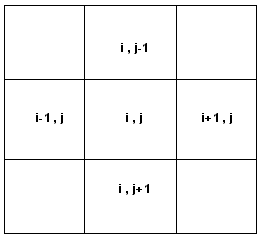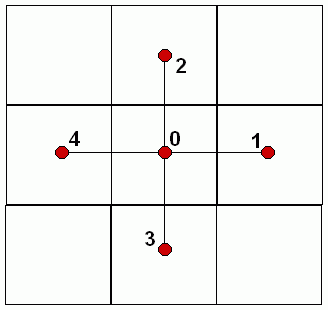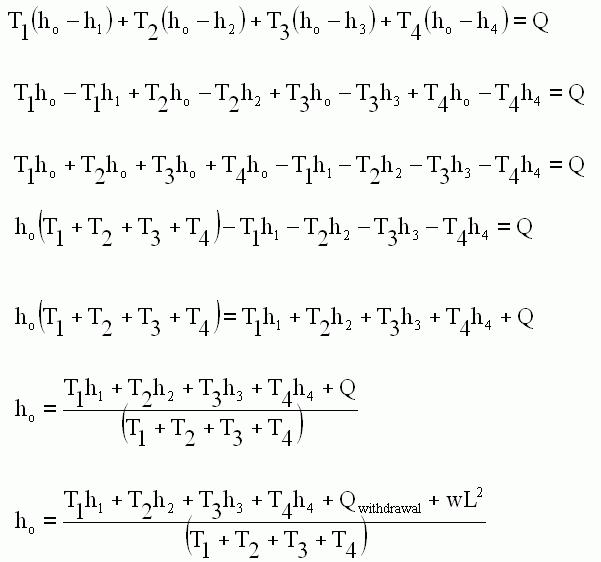
Consider a spreadsheet calculation for the general steady state case at a node completely surrounded by active nodes:

Simplify to consider the 5 point star:

By continuity the flow from node 1 to 0 plus the flow from node 2 to 0 plus the flow from node 3 to 0 plus the flow from node 4 to 0 must equal the net flux at the node:
![]()
The net flux may be zero, or it might be equal to a pumping/injection rate, or to a head dependent flux such as flow to a surface water body, or to recharge rate times the area of the cell, or some combination of these. Let a Qwithdrawal represent any pumping or other flux, w be the recharge rate and cells be square with L the cell size, and we can express Q as:
![]()
By Darcy's law with hydraulic conductivity K and thickness b:

For square cells of constant size:
![]()
Given that T=Kb
![]()
Substituting for q and Q, then rearranging and simplifying, we arrive at the expression we can use in a spread sheet:

Notice the T values are for the cell faces so they are the harmonic mean T for adjacent cells. Given the constant cell size, this simplifies to:

For cells near no flow boundaries, the portion of the equation representing flow across that boundary must be eliminated. For example, if the face between cell 0 and the top of the page (cell 2) is a no-flow boundary then the terms related to flow from node 2 will be omitted:

For more on spreadsheet finite difference models, see: Olsthoorn, 1985, The power of the electronic spreadsheet: Modeling without special programs, Ground Water, Vol 23, no. 3. And a response to comment.
Note the solution requires an
iterative calculation so you must allow for circular references in Excel. Currently
this it done via:
Tools > Options > Calculation
Check iteration, Adjust maximum # and tolerance to get a precise answer
Examine a simple example
spreadsheet now. Study how it works, then modify it to be similar to your problem
and submit next week with the grid, boundary conditions and material properties
you plan to use in MODFLOW. Your spreadsheet version can be a simplified situation.
SIMPLE STEADY-STATE CONFINED
SPREADSHEET FINITE-DIFFERENCE MODEL XLS
Consider what you might do to add features, layers, transients, unconfined conditions
and so on. If you are getting bogged down in your pursuit, take a break and
revisit it, eventually consider trying to tackle a simpler problem..